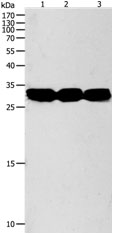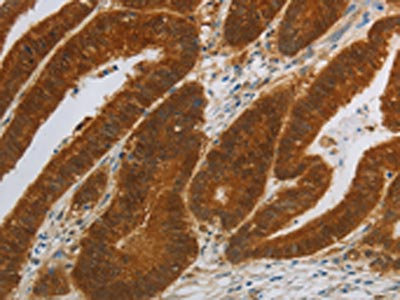![IHC-P analysis of colon adenocarcinoma tissue using GTX84036 NIT2 antibody [2B9]. Antigen retrieval : Heat-induced epitope retrieval by 10mM citrate buffer, pH6.0, 100oC for 10min. Dilution : 1:50 IHC-P analysis of colon adenocarcinoma tissue using GTX84036 NIT2 antibody [2B9]. Antigen retrieval : Heat-induced epitope retrieval by 10mM citrate buffer, pH6.0, 100oC for 10min. Dilution : 1:50](https://www.genetex.com/upload/website/prouct_img/normal/GTX84036/GTX84036_2216_IHC-P_w_23061420_254.webp)
IHC-P analysis of colon adenocarcinoma tissue using GTX84036 NIT2 antibody [2B9]. Antigen retrieval : Heat-induced epitope retrieval by 10mM citrate buffer, pH6.0, 100oC for 10min. Dilution : 1:50
NIT2 antibody [2B9]
GTX84036
ApplicationsFlow Cytometry, ImmunoFluorescence, Western Blot, ImmunoCytoChemistry, ImmunoHistoChemistry, ImmunoHistoChemistry Paraffin
Product group Antibodies
TargetNIT2
Overview
- SupplierGeneTex
- Product NameNIT2 antibody [2B9]
- Delivery Days Customer9
- Application Supplier NoteWB: 1:2000. ICC/IF: 1:100. IHC-P: 1:50. FACS: 1:100. *Optimal dilutions/concentrations should be determined by the researcher.Not tested in other applications.
- ApplicationsFlow Cytometry, ImmunoFluorescence, Western Blot, ImmunoCytoChemistry, ImmunoHistoChemistry, ImmunoHistoChemistry Paraffin
- CertificationResearch Use Only
- ClonalityMonoclonal
- Clone ID2B9
- Concentration0.74 mg/ml
- ConjugateUnconjugated
- Gene ID56954
- Target nameNIT2
- Target descriptionnitrilase family member 2
- Target synonymsHEL-S-8a, omega-amidase NIT2, Nit protein 2, epididymis secretory sperm binding protein Li 8a, nitrilase homolog 2
- HostMouse
- IsotypeIgG2b
- Protein IDQ9NQR4
- Protein NameOmega-amidase NIT2
- Scientific DescriptionHas a omega-amidase activity. The role of omega-amidase is to remove potentially toxic intermediates by converting alpha-ketoglutaramate and alpha-ketosuccinamate to biologically useful alpha-ketoglutarate and oxaloacetate, respectively. Overexpression decreases the colony-forming capacity of cultured cells by arresting cells in the G2 phase of the cell cycle.
- Storage Instruction-20°C or -80°C,2°C to 8°C
- UNSPSC12352203

![IHC-P analysis of liver carcinoma tissue using GTX84036 NIT2 antibody [2B9]. Antigen retrieval : Heat-induced epitope retrieval by 10mM citrate buffer, pH6.0, 100oC for 10min. Dilution : 1:50 IHC-P analysis of liver carcinoma tissue using GTX84036 NIT2 antibody [2B9]. Antigen retrieval : Heat-induced epitope retrieval by 10mM citrate buffer, pH6.0, 100oC for 10min. Dilution : 1:50](https://www.genetex.com/upload/website/prouct_img/normal/GTX84036/GTX84036_2217_IHC-P_w_23061420_135.webp)
![IHC-P analysis of liver tissue using GTX84036 NIT2 antibody [2B9]. Antigen retrieval : Heat-induced epitope retrieval by 10mM citrate buffer, pH6.0, 100oC for 10min. Dilution : 1:50 IHC-P analysis of liver tissue using GTX84036 NIT2 antibody [2B9]. Antigen retrieval : Heat-induced epitope retrieval by 10mM citrate buffer, pH6.0, 100oC for 10min. Dilution : 1:50](https://www.genetex.com/upload/website/prouct_img/normal/GTX84036/GTX84036_2218_IHC-P_w_23061420_872.webp)
![IHC-P analysis of pancreas tissue using GTX84036 NIT2 antibody [2B9]. Antigen retrieval : Heat-induced epitope retrieval by 10mM citrate buffer, pH6.0, 100oC for 10min. Dilution : 1:50 IHC-P analysis of pancreas tissue using GTX84036 NIT2 antibody [2B9]. Antigen retrieval : Heat-induced epitope retrieval by 10mM citrate buffer, pH6.0, 100oC for 10min. Dilution : 1:50](https://www.genetex.com/upload/website/prouct_img/normal/GTX84036/GTX84036_2219_IHC-P_w_23061420_292.webp)
![FACS analysis of HEK293T cells transfected with either NIT2 plasmid(Red) or empty vector control plasmid(Blue) using GTX84036 NIT2 antibody [2B9]. FACS analysis of HEK293T cells transfected with either NIT2 plasmid(Red) or empty vector control plasmid(Blue) using GTX84036 NIT2 antibody [2B9].](https://www.genetex.com/upload/website/prouct_img/normal/GTX84036/GTX84036_281_FACS_w_23061420_986.webp)
![WB analysis of wild type and NIT2 knock out 293T cell lysate(10microg per lane) using GTX84036 NIT2 antibody [2B9]. Dilution : 1:500 WB analysis of wild type and NIT2 knock out 293T cell lysate(10microg per lane) using GTX84036 NIT2 antibody [2B9]. Dilution : 1:500](https://www.genetex.com/upload/website/prouct_img/normal/GTX84036/GTX84036_4081_20181228_WB_w_23061420_683.webp)
![WB analysis of HEK293T cells transfected with NIT2 plasmid (Right) or empty vector (Left) for 48 hrs using GTX84036 NIT2 antibody [2B9]. Loading : 5 ug per lane WB analysis of HEK293T cells transfected with NIT2 plasmid (Right) or empty vector (Left) for 48 hrs using GTX84036 NIT2 antibody [2B9]. Loading : 5 ug per lane](https://www.genetex.com/upload/website/prouct_img/normal/GTX84036/GTX84036_4082_WB_w_23061420_614.webp)
![ICC/IF analysis of COS7 cells transiently transfected with NIT2 plasmid using GTX84036 NIT2 antibody [2B9]. ICC/IF analysis of COS7 cells transiently transfected with NIT2 plasmid using GTX84036 NIT2 antibody [2B9].](https://www.genetex.com/upload/website/prouct_img/normal/GTX84036/GTX84036_920_ICCIF_w_23061420_617.webp)


![IHC-P analysis of colon adenocarcinoma tissue using GTX84039 NIT2 antibody [3D5]. Antigen retrieval : Heat-induced epitope retrieval by 10mM citrate buffer, pH6.0, 100oC for 10min. Dilution : 1:50](https://www.genetex.com/upload/website/prouct_img/normal/GTX84039/GTX84039_2220_IHC-P_w_23061420_446.webp)
![IHC-P analysis of colon adenocarcinoma tissue using GTX84040 NIT2 antibody [6H7]. Antigen retrieval : Heat-induced epitope retrieval by 10mM citrate buffer, pH6.0, 100oC for 10min. Dilution : 1:50](https://www.genetex.com/upload/website/prouct_img/normal/GTX84040/GTX84040_2223_IHC-P_w_23061420_820.webp)


